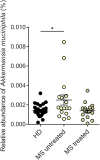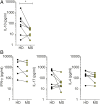Gut microbiota from multiple sclerosis patients enables spontaneous autoimmune encephalomyelitis in mice
- PMID: 28893994
- PMCID: PMC5635914
- DOI: 10.1073/pnas.1711233114
Gut microbiota from multiple sclerosis patients enables spontaneous autoimmune encephalomyelitis in mice
Abstract
There is emerging evidence that the commensal microbiota has a role in the pathogenesis of multiple sclerosis (MS), a putative autoimmune disease of the CNS. Here, we compared the gut microbial composition of 34 monozygotic twin pairs discordant for MS. While there were no major differences in the overall microbial profiles, we found a significant increase in some taxa such as Akkermansia in untreated MS twins. Furthermore, most notably, when transplanted to a transgenic mouse model of spontaneous brain autoimmunity, MS twin-derived microbiota induced a significantly higher incidence of autoimmunity than the healthy twin-derived microbiota. The microbial profiles of the colonized mice showed a high intraindividual and remarkable temporal stability with several differences, including Sutterella, an organism shown to induce a protective immunoregulatory profile in vitro. Immune cells from mouse recipients of MS-twin samples produced less IL-10 than immune cells from mice colonized with healthy-twin samples. IL-10 may have a regulatory role in spontaneous CNS autoimmunity, as neutralization of the cytokine in mice colonized with healthy-twin fecal samples increased disease incidence. These findings provide evidence that MS-derived microbiota contain factors that precipitate an MS-like autoimmune disease in a transgenic mouse model. They hence encourage the detailed search for protective and pathogenic microbial components in human MS.
Keywords: experimental autoimmune encephalomyelitis; germ-free mice; gut microbiome; multiple sclerosis; twin study.
Conflict of interest statement
The authors declare no conflict of interest.
Figures











Comment in
-
Multiple sclerosis: A possible link between multiple sclerosis and gut microbiota.Nat Rev Neurol. 2017 Dec;13(12):705. doi: 10.1038/nrneurol.2017.142. Epub 2017 Sep 29. Nat Rev Neurol. 2017. PMID: 28960186 No abstract available.
-
A gut feeling about multiple sclerosis.Proc Natl Acad Sci U S A. 2017 Oct 3;114(40):10528-10529. doi: 10.1073/pnas.1714260114. Epub 2017 Sep 25. Proc Natl Acad Sci U S A. 2017. PMID: 28973867 Free PMC article. No abstract available.
Similar articles
-
Gut bacteria from multiple sclerosis patients modulate human T cells and exacerbate symptoms in mouse models.Proc Natl Acad Sci U S A. 2017 Oct 3;114(40):10713-10718. doi: 10.1073/pnas.1711235114. Epub 2017 Sep 11. Proc Natl Acad Sci U S A. 2017. PMID: 28893978 Free PMC article.
-
Gut Microbiota in Multiple Sclerosis and Experimental Autoimmune Encephalomyelitis: Current Applications and Future Perspectives.Mediators Inflamm. 2018 Apr 2;2018:8168717. doi: 10.1155/2018/8168717. eCollection 2018. Mediators Inflamm. 2018. PMID: 29805314 Free PMC article. Review.
-
The gut-brain connection: triggering of brain autoimmune disease by commensal gut bacteria.Rheumatology (Oxford). 2016 Dec;55(suppl 2):ii68-ii75. doi: 10.1093/rheumatology/kew353. Rheumatology (Oxford). 2016. PMID: 27856664 Review.
-
Interactions between host genetics and gut microbiota determine susceptibility to CNS autoimmunity.Proc Natl Acad Sci U S A. 2020 Nov 3;117(44):27516-27527. doi: 10.1073/pnas.2002817117. Epub 2020 Oct 19. Proc Natl Acad Sci U S A. 2020. PMID: 33077601 Free PMC article.
-
Disease of the holobiont, the example of multiple sclerosis.Med Clin (Barc). 2019 Feb 15;152(4):147-153. doi: 10.1016/j.medcli.2018.08.019. Epub 2018 Nov 10. Med Clin (Barc). 2019. PMID: 30424933 Review. English, Spanish.
Cited by
-
Lactobacillaceae differentially impact butyrate-producing gut microbiota to drive CNS autoimmunity.Gut Microbes. 2024 Jan-Dec;16(1):2418415. doi: 10.1080/19490976.2024.2418415. Epub 2024 Oct 27. Gut Microbes. 2024. PMID: 39462277 Free PMC article.
-
The Microbiota-Gut-Brain Axis and Neurological Disorders: A Comprehensive Review.Life (Basel). 2024 Sep 26;14(10):1234. doi: 10.3390/life14101234. Life (Basel). 2024. PMID: 39459534 Free PMC article. Review.
-
The role of the gut microbiota in neurodegenerative diseases targeting metabolism.Front Neurosci. 2024 Sep 26;18:1432659. doi: 10.3389/fnins.2024.1432659. eCollection 2024. Front Neurosci. 2024. PMID: 39391755 Free PMC article. Review.
-
Prebiotic inulin controls Th17 cells mediated central nervous system autoimmunity through modulating the gut microbiota and short chain fatty acids.Gut Microbes. 2024 Jan-Dec;16(1):2402547. doi: 10.1080/19490976.2024.2402547. Epub 2024 Sep 17. Gut Microbes. 2024. PMID: 39287045 Free PMC article.
-
Reconstruction characteristics of gut microbiota from patients with type 1 diabetes affect the phenotypic reproducibility of glucose metabolism in mice.Sci China Life Sci. 2024 Sep 13. doi: 10.1007/s11427-024-2658-1. Online ahead of print. Sci China Life Sci. 2024. PMID: 39285046
References
-
- Wekerle H. Nature plus nurture: The triggering of multiple sclerosis. Swiss Med Wkly. 2015;145:w14189. - PubMed
-
- Sawcer S, Franklin RJ, Ban M. Multiple sclerosis genetics. Lancet Neurol. 2014;13:700–709. - PubMed
-
- Berer K, Krishnamoorthy G. Microbial view of central nervous system autoimmunity. FEBS Lett. 2014;588:4207–4213. - PubMed
-
- Wekerle H, Hohlfeld R. Gut Microbiota in Multiple Sclerosis: A Bioreactor Driving Brain Autoimmunity. Elsevier; Amsterdam: 2016. pp. 113–123.
Publication types
MeSH terms
Grants and funding
LinkOut - more resources
Full Text Sources
Other Literature Sources
Medical
Molecular Biology Databases

